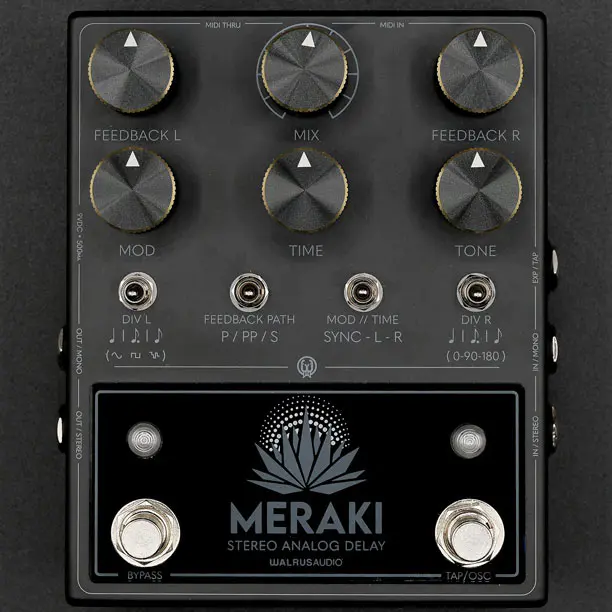
Thi is the “blacked out” version of the Meraki, released in late 2023 via a Reverb.com special. The stock version looks like this.
The race to build the best stereo analog delay is on, ladies and gentlemen! The Walrus Audio Meraki, released under Reverb.com’s multi-builder 2023 Blackout Series initiative, joins the BOSS DM-101 in an effect category that’s universally considered hard to crack for its engineering challenges, including the fact that this kind of circuit requires a lot of BBD chips – 8 in this case.
The Meraki can produce up to 1200 ms of warm analog repeats, while opening up a world of tweaking options thanks to its 6 knobs (including separate L/R Feedback controls), 4 toggle switches, and 2 footswitches. The other four tackle Mix, Time, Tone, and Modulation, with the latter doubling as Modulation Rate if operated while pressing the bypass footswitch.
On the toggle side of things, there are 3 separate subdivision options for each channel (quarter note, dotted eighth, and eighth note). Those two toggles also have an alt function that allows to pick from 3 waveforms (sine, square and random) and 0-90-180 phase shifting.
The Feedback Path switch is a little bit like the “mode” selector, delivering 3 types of delay:
- Parallel: the feedback paths for the left and right channels operate independently. The left channel repeats feedback exclusively into its own input, while the right channel does the same for its input.
- Ping-Pong: the feedback alternates between the left and right inputs. The left channel repeats feedback into the right input, and concurrently, the right channel sends feedback to the left input. This creates a back-and-forth bouncing effect between the two sides.
- Series: the left channel repeats feedback into both its own input and the input of the right delay line. Similarly, the right channel repeats feedback into its own input, and additionally, incorporates the feedback from the left channel into the right input, crafting intricate and syncopated results.
But it’s the Sync/Left/Right Switch that’s the real treat here: it allows to “desync” all the controls so that you can create two delay lines completely independent from each other!
The pedal also features Tap Tempo, Expression Input and Midi Integration. The Tap Tempo footswitch generates Momentary Oscillation when held.






















